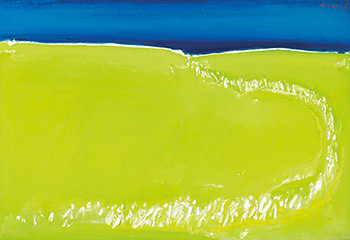Catalogue Note:
"Indonesian artist Srihadi Sudarsono regarded as one of the most renowned and prolific living modern artists, his ability to capture the constant changes in nature and the cosmic world around him, is apparent in his poetic paintings. In 1962, Sudarsono received his Master's degree from Ohio State University, exposed to Post- War art in the USA at the zenith of Abstract Expressionism, Srihadi was mesmerized by the potential of Western modernism and began experimenting with myriad styles. However, he soon realized the importance of needs to develop his own individual style. Having returned to Indonesia in search of his root, the ""root"" begins from the inner beliefs and soul not just the external world. As a believer of Javanese cosmology, strongly relied on one's personal laku batin, or inner behavior, when in the process of building his creative opus, this belief is reflected in the works of Sudarsono.
The incredible lot ""Procession to the Sea"" presented here is done with maturity. Sudarsono employed saturated grassy light green upfront, then applied thick impastos of white as depiction of curve roads, the eyes are directed along with the white touches towar ds the seafront, the use of white lines appear like tides at the beach divided the border of sea and land, finally reaching the boundless deep blue sea, gazing afar. The painting is visually r eminiscent of Mark Rothko's abstract paintings, the color fields are used to divide the sky and land into two separate worlds. However, what differs from the work of Rothko to that of Sudarsono is that the latter has blended the essence of abstract and figurative paintings, emphasizing expression of colors. The simplistic layout is harmonized with orderly composition, Sudarsono projects an abstract, extrasensory vision of the landscape, uniting the beauty of nature and the cosmic world. ""What you see in my painting is not a physical impr ession but rather a manifestation of the spiritual essence of the subject"", Sudarsono explained.
The early works of Sudarsono is characterized of anti-colonial themes, they reflected the uncertainty of political situation under the Dutch occupation. Later in the 1960s, he had the good fortune to receive a scholarship to study in the United States, where he was exposed to the Western art movements, such as Pop Art, Minimalism, and Abstract Expressionism of the decade, it was an eye-opening experience for Sudarsono. The artist began to evaluate the inner core and beliefs, he believed that Art is a thought process, and thinks that the concept of artistic activity is as of channeling of the positive
energy that emanates from a combination of spirit, feeling, and will.
These factors are at the core of man's creative ability. The reason that Sudarsono has been widely admired is because he is among the very few artists who has returned to the root of their own even after receiving Western education. More importantly, Sudarsono continued to distribute positive energy to the world through his creations, even for someone who is alr eady 81 year-old. "
The incredible lot ""Procession to the Sea"" presented here is done with maturity. Sudarsono employed saturated grassy light green upfront, then applied thick impastos of white as depiction of curve roads, the eyes are directed along with the white touches towar ds the seafront, the use of white lines appear like tides at the beach divided the border of sea and land, finally reaching the boundless deep blue sea, gazing afar. The painting is visually r eminiscent of Mark Rothko's abstract paintings, the color fields are used to divide the sky and land into two separate worlds. However, what differs from the work of Rothko to that of Sudarsono is that the latter has blended the essence of abstract and figurative paintings, emphasizing expression of colors. The simplistic layout is harmonized with orderly composition, Sudarsono projects an abstract, extrasensory vision of the landscape, uniting the beauty of nature and the cosmic world. ""What you see in my painting is not a physical impr ession but rather a manifestation of the spiritual essence of the subject"", Sudarsono explained.
The early works of Sudarsono is characterized of anti-colonial themes, they reflected the uncertainty of political situation under the Dutch occupation. Later in the 1960s, he had the good fortune to receive a scholarship to study in the United States, where he was exposed to the Western art movements, such as Pop Art, Minimalism, and Abstract Expressionism of the decade, it was an eye-opening experience for Sudarsono. The artist began to evaluate the inner core and beliefs, he believed that Art is a thought process, and thinks that the concept of artistic activity is as of channeling of the positive
energy that emanates from a combination of spirit, feeling, and will.
These factors are at the core of man's creative ability. The reason that Sudarsono has been widely admired is because he is among the very few artists who has returned to the root of their own even after receiving Western education. More importantly, Sudarsono continued to distribute positive energy to the world through his creations, even for someone who is alr eady 81 year-old. "
